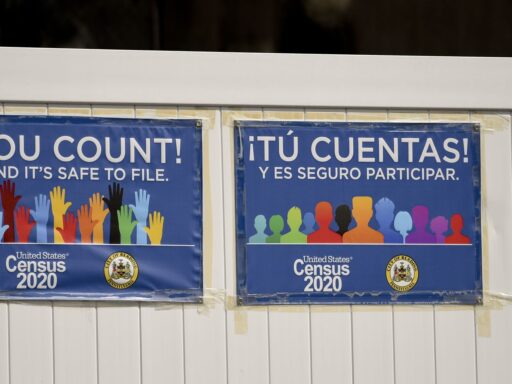Census officials have reportedly stopped working on Trump’s plan to exclude undocumented immigrants from census counts, which are used to redraw electoral maps.
Census officials are no longer proceeding with President Donald Trump’s plan to exclude undocumented immigrants living in the US from census population counts for purposes of redrawing congressional districts in 2021, according to an NPR report. The news outlet reported that senior career officials at the Census Bureau had ordered the work to stop immediately on Tuesday night.
The move brings an apparent end to Trump’s controversial attempt to erode the political power of immigrant communities. Excluding undocumented immigrants would have reduced the population counts in areas where foreign-born populations have traditionally settled — primarily Democrat-run cities — and therefore undermined their political power. But it could have also affected red states with large immigrant populations, including Texas.
States currently draw congressional districts, determining the areas that each elected official represents based on the total population, including unauthorized immigrants. The current maps are due to be redrawn this year after the results of the 2020 census come in, and the stakes are high: Each redistricting has a lasting influence on who is likely to win elections, which communities will be represented in Congress, and, ultimately, which laws will be passed. If states can’t complete their redistricting efforts ahead of upcoming elections, including the midterms in 2022, courts can intervene and draw temporary maps.
Trump issued a memorandum last July arguing that, by law, the president has the final say over who must be counted in the census. And Trump has said that unauthorized immigrants should not be counted because it would undermine American representative democracy and create “perverse incentives” for those seeking to come to the US.
But in September, a panel of three federal judges found that Trump’s memorandum skirted the federal government’s constitutional obligation to count every person, no matter their immigration status, in the census every 10 years.
Though Trump had asked the Supreme Court to weigh in, the justices were reluctant to do so absent any estimate from the Census bureau of how many undocumented immigrants would be excluded from the apportionment counts. In December, they ruled in an unsigned opinion that it would be “premature” to issue a final decision on the issue, giving the Trump administration little ammunition with which to move forward.
Trump’s attempt to use the census against immigrants was part of a long-term Republican strategy
The US is on track to become a majority-nonwhite nation sometime in the 2040s, with Latinos accounting for a large portion of that growth. For Republicans who have relied on primarily non-Latino white, rural voters to stay in office, those demographic changes could pose a serious threat to the party’s power.
But even before Trump, they had hatched a plan to maintain their grip on power for at least a little while longer: They would exclude noncitizens from the census population counts used to redraw congressional districts. The late Republican political strategist Thomas Hofeller was the mastermind behind the plan, which he believed could keep state legislatures in Texas, Georgia, Arizona, and Florida from flipping blue in the near future. It would have the effect of diluting the political power of foreign-born people — who have primarily settled in Democrat-run cities — relative to more rural, Republican-run areas.
Trump, for his part, has embraced the strategy and taken it even further.
Trump previously sought to put a question about citizenship status on the 2020 census. Several states, including California and New York, challenged the question in court on the basis that it would depress response rates among immigrant communities, leading to an undercount that would cost their governments critical federal funding. Their lawsuit came before the Supreme Court, which ruled in their favor in June 2019 on the basis that the Trump administration had lied about why it chose to include the question on the census.
Trump had argued that citizenship data would aid the Justice Department’s enforcement of the prohibitions against racial discrimination in voting. But that rationale was just a pretext, introduced after the fact to justify the question and meant to obscure the administration’s actual reasoning, the justices found.
Had the administration decided to continue pursuing the citizenship question, it would have had to race to support its decision with more valid reasoning in order to print the census forms on time.
Trump ultimately decided against doing so, instead issuing an executive order in July 2019 that instructed the Census Bureau to estimate citizenship data using enhanced state administrative records.
His July 2020 memorandum excluding unauthorized immigrants living in the US from census population counts for purposes of redrawing congressional districts in 2021 was the culmination of that effort. But it appeared not to succeed on Wednesday.
Author: Nicole Narea
Read More



